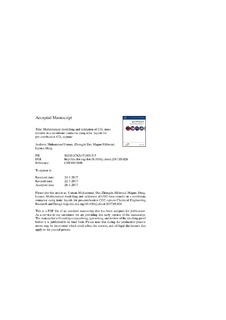| dc.contributor.author | Usman, Muhammad | |
| dc.contributor.author | Dai, Zhongde | |
| dc.contributor.author | Hillestad, Magne | |
| dc.contributor.author | Deng, Liyuan | |
| dc.date.accessioned | 2017-11-02T14:38:50Z | |
| dc.date.available | 2017-11-02T14:38:50Z | |
| dc.date.created | 2017-06-29T10:35:54Z | |
| dc.date.issued | 2017 | |
| dc.identifier.citation | Chemical engineering research & design. 2017, 123 377-387. | nb_NO |
| dc.identifier.issn | 0263-8762 | |
| dc.identifier.uri | http://hdl.handle.net/11250/2463794 | |
| dc.description.abstract | Mass transfer and mathematical modelling of CO2 absorption in a tubular membrane contactor using 1-Butyl-3-methylimidazolium Tricyanomethanide ([Bmim][TCM]) for pre-combustion CO2 capture has been studied in this work. A 1D-model was developed based on resistance in series model and CO2 material balance. The developed model was validated with the experimental data, and good agreement was observed between the simulated and experimental results. A new mass transfer resistance term is added to reflect the non-flat concentration profile in the liquid phase. Simulation results indicate that the liquid phase resistance contributes 67% and 44% to the total mass transfer resistance for non-wetted and wetted modes of membrane respectively. The resistance that occurred due to considering transport in liquid phase contributes 31 and 20% for non-wetted and wetted modes of membrane contactor respectively. CO2 flux along the axial length of membrane contactor was modeled, giving the maxima at the gas outlet. The influences of operational constraints including liquid/gas flow rates, operation pressure/temperature, length of membrane contactor, and CO2 concentration in feed gas were also inspected. | nb_NO |
| dc.language.iso | eng | nb_NO |
| dc.publisher | Elsevier | nb_NO |
| dc.rights | Attribution-NonCommercial-NoDerivatives 4.0 Internasjonal | * |
| dc.rights.uri | http://creativecommons.org/licenses/by-nc-nd/4.0/deed.no | * |
| dc.title | Mathematical modeling and validation of CO2 mass transfer in a membrane contactor using ionic liquids for pre-combustion CO2 capture | nb_NO |
| dc.type | Journal article | nb_NO |
| dc.type | Peer reviewed | nb_NO |
| dc.description.version | acceptedVersion | nb_NO |
| dc.source.pagenumber | 377-387 | nb_NO |
| dc.source.volume | 123 | nb_NO |
| dc.source.journal | Chemical engineering research & design | nb_NO |
| dc.identifier.doi | 10.1016/j.cherd.2017.05.026 | |
| dc.identifier.cristin | 1479764 | |
| dc.description.localcode | © 2017. This is the authors’ accepted and refereed manuscript to the article. LOCKED until 9.6.2019 due to copyright restrictions. This manuscript version is made available under the CC-BY-NC-ND 4.0 license http://creativecommons.org/licenses/by-nc-nd/4.0/ | nb_NO |
| cristin.unitcode | 194,66,30,0 | |
| cristin.unitname | Institutt for kjemisk prosessteknologi | |
| cristin.ispublished | true | |
| cristin.fulltext | preprint | |
| cristin.qualitycode | 1 | |

